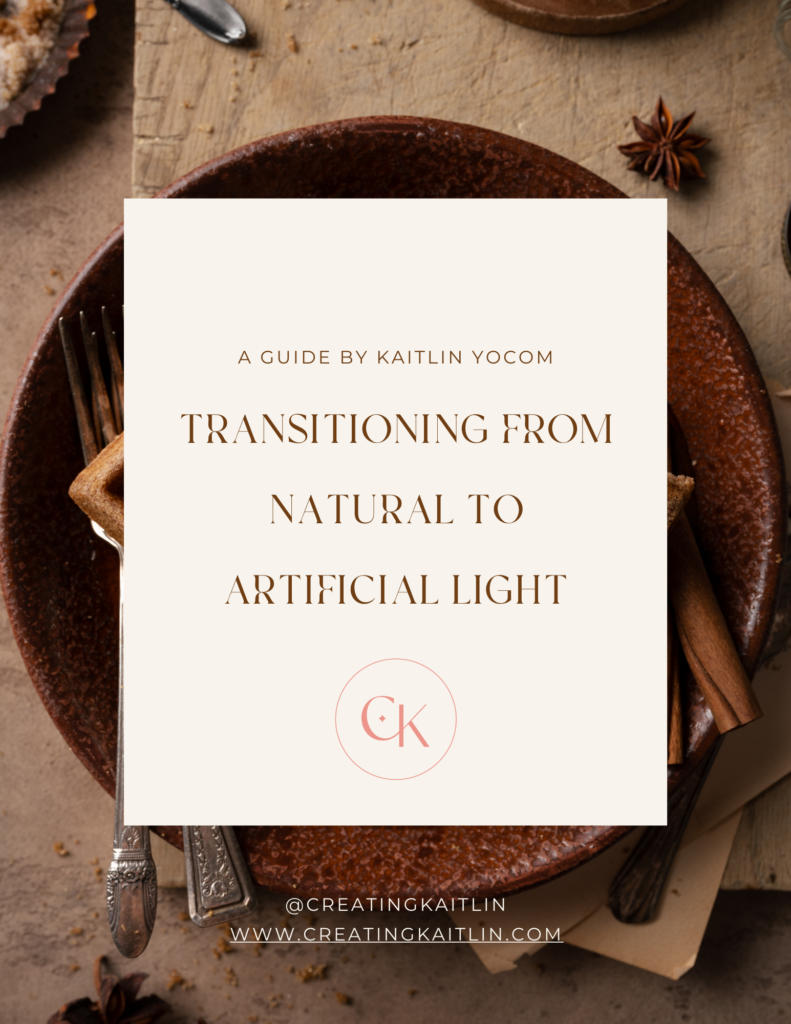How to Make Artificial Light Look Natural in Food Photography

When chatting with other food photographers, one of the biggest fears they express is that switching to artificial light will make their food look fake or flat. I totally understand this fear, because I had the same exact thoughts. When I made the switch from natural to artificial light in 2021, I quickly learned that artificial light was magic & took my photography to the next level. So in this post, we’re going to talk about how to make artificial light look natural in food photography.
1. Shoot in Manual Mode
This is the biggest tip for all photographers. If you aren’t shooting in manual mode, you really need to be. Shooting in manual mode gives you complete control over your scene & how you want it to look. Get comfortable with your camera & know how to adjust the white balance, shutter speed, aperture, & ISO.
I’ve found that when my scene is overexposed, that’s when my food most often looks fake & flat. Dialing in my camera settings to achieve a correctly exposed scene is the first step in making artificial light look natural. Simply quickening my shutter speed so not as much light passes through usually does the trick.
2. Use a Modifier
A modifier is a softbox or some type of diffusion material that takes a more direct light & spreads it out to create a soft, even light. I use two different modifiers in my food photography — a rectangular softbox & an octagon umbrella style softbox. Both of these modifiers give me a lovely soft light that mimics natural light.
Think about natural light in food photography. Typically, you’re shooting by a nice, big window that’s letting in a lot of light. We want that same effect in our artificial light photography. This is why a modifier/softbox is so helpful to turn artificial light from a hard, direct light into a soft, diffused light.

3. Adjust Your Surroundings Based on Your Type of Light
What do I mean by this? In food photography, there are two different types of lights we use — flash & continuous. Let’s go over their differences below.
Flash
can only be used for photography (cannot be used for videos)
cancels out ambient light (this means you can keep overhead lights on or curtains drawn back from windows)
a burst of light fires only when a picture is being taken
captures incredible action shots/freezes action
Continuous
can be used for both photography & videography
does not cancel out ambient light (this means all other lights must be turned off or blocked, otherwise the other lights will impact your photo)
reminds me more of natural light/mimics natural light because…
once turned on, a continuous light will give you a constant light
doesn’t freeze action like flash does (unless of course your shutter speed is extremely fast)
Basically, if you choose to use a continuous light, you need to be sure your surroundings are controlled. All other lights need to be turned off, curtains need to be drawn over windows, & the only light that should be on is the continuous light. Any additional lights will impact your final photo in a negative way.
4. Know How to Manipulate Your Light
This is a concept you should be familiar with if you’ve been shooting with natural light. It’s important to know how to manipulate your light to achieve a desired look in your food photos. If the shadows appear too dark in your photo & you want to lighten them up, add in a white bounce card for some fill light. If you want a moodier scene, a black card would help to absorb additional light that may be making your scene look too bright. Positioning your light source at different angles can also change the way your light hits your scene in big ways. Try backlight & then sidelight. Compare the two images & pick out the subtle differences. These differences can have a huge impact on your final photo.

I hope this was helpful! If you want to dive deeper into transitioning from natural to artificial light, you can check out my eBook where I teach you how to take food photos full of depth & dimension using artificial light. I also go over…
pros vs. cons of both natural & artificial light
over 45 minutes of video content showing you how to set up your flash & continuous light & different ways to manipulate artificial light
getting the flash & trigger to communicate with each other
steps to taking your first photo with artificial light
hurdles to overcome with artificial light & how to solve them
& more!
Once you make the switch to artificial light, you’ll wish you would’ve done it sooner!
Check out my other artificial light blog posts:

COMMENTS